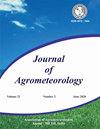印度旁遮普全年移栽条件下非洲万寿菊的物候期、热量单位需求和热量利用效率
Q3 Agricultural and Biological Sciences
引用次数: 0
摘要
本研究于 2021-22 年和 2022-23 年期间在印度旁遮普省卢迪亚纳的旁遮普农业大学进行,旨在研究非洲万寿菊全年移栽的作物物候、热量单位需求和热量利用效率(HUE)。雨季(尤其是 8 月份)移栽的作物种子和花朵产量的热利用效率最高。春季和夏季移栽(2 月至 6 月)时,由于昼长条件较长,达到花蕾可见度和 50 % 开花期的生长度日(GDD)和光热单位(PTU)较高,这迫使作物种子灌浆期较短,种子产量和 HUE 较低。然而,与夏季移栽相比,万寿菊的最佳种子产量期(雨季移栽)在达到花蕾可见度和 50%开花期时的 GDD 和 PTU 较小,因此种子灌浆期较长,种子产量较高。值得注意的是,雨季移栽的作物与其他季节移栽的作物相比,种子灌浆期的 GDD 和 PTU 值更高。为了解雨季移栽获得高种子产量的天气变量作用,进行了相关研究。非洲万寿菊的种子产量与种子生产的 HUE 相关性值最高(r2= 0.978),其次分别是种子灌浆期的 GDD(r2= 0.810)、花朵生产的 HUE(r2= 0.787)和种子灌浆期的 PTU(r2= 0.774)。显然,种子灌浆期的平均温度和日照时数是非洲万寿菊种子产量的最重要决定因素。本文章由计算机程序翻译,如有差异,请以英文原文为准。
Phenology, heat unit requirement and heat use efficiency of African marigold under year-round transplanting conditions of Punjab, India
The present study was conducted during 2021-22 and 2022-23 to study crop phenology, heat unit requirement and heat use efficiency (HUE) in African marigold under year-round transplanting at Punjab Agricultural University, Ludhiana, Punjab, India. The highest heat use efficiency for seed and flower production were recorded in crop transplanted in rainy season particularly in the month of August. Higher growing degree days (GDD) and photothermal units (PTU) for attaining bud visibility and 50 % flowering stages were recorded under spring and summer transplanting (February to June) due to longer day length conditions which forced the crop to witness shorter seed filling period with lesser seed yield and HUE. Optimum seed yield period in marigold (rainy season transplanting), however, recorded lesser GDD and PTU for attainment of bud visibility and 50 % flowering as compared to summer transplanting dates and consequently had longer seed filling period resulting in higher seed yield. Notably, GDD and PTU for seed filling period recorded higher values in rainy season transplanted crop as compared to crop transplanted in other seasons of year. Correlation studies were conducted to understand the role of weather variables for high seed yield obtained under rainy season transplanting. Seed yield in African marigold recorded the highest value of correlation with HUE for seed production (r2= 0.978) followed by GDD for seed filling period (r2= 0.810), HUE for flower production (r2= 0.787) and PTU for seed filling period (r2= 0.774), respectively. Apparently, mean temperature and sunshine hours during seed filling period are the most important determinants of seed yield in African marigold.
求助全文
通过发布文献求助,成功后即可免费获取论文全文。
去求助
来源期刊

Journal of Agrometeorology
农林科学-农艺学
CiteScore
1.40
自引率
0.00%
发文量
95
审稿时长
>12 weeks
期刊介绍:
The Journal of Agrometeorology (ISSN 0972-1665) , is a quarterly publication of Association of Agrometeorologists appearing in March, June, September and December. Since its beginning in 1999 till 2016, it was a half yearly publication appearing in June and December. In addition to regular issues, Association also brings out the special issues of the journal covering selected papers presented in seminar symposia organized by the Association.
 求助内容:
求助内容: 应助结果提醒方式:
应助结果提醒方式:


